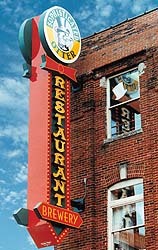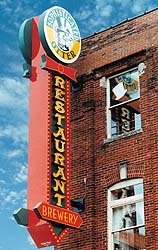Perhaps more than any other substance, plastic serves as the cornerstone of the modern age. Its development falls neatly within the framework of the 20th century, and its influence has extended into almost every aspect of modern life. In the 1950s, French philosopher Roland Barthes said plastic symbolized man’s desire for transformability and duration in the face of natural forces. In the 60s, thanks in part to the classic coming-of-age film "The Graduate," plastic underwent a negative semantic shift, becoming a synonym for "phony." Despite its detractors, plastic is everywhere, a pervasive presence in our society. In many ways, plastic can be considered a hallmark of human ingenuity. During the 19th century, advances in chemistry unlocked the elements of the natural world. Scientists tapping the resources of lumber, petroleum and coal discovered many by-products that held promise and warranted further investigation. Chemists began working with resins and fibers, experimenting with melting points and physical properties. The forerunner to modern plastics debuted in 1907. Belgian émigré Leo Baekeland set out to develop a synthetic varnish. By combining formaldehyde with phenols, the chemist created a substance that offered three key characteristics: durability, extrudability and moldability. Dubbed "Bakelite," the substance could be easily molded into radio cabinets, pipe stems and appliance housings. It was hard, sturdy and resistant to oxidation.
Bakelite products sparked a revolution in the development of man-made materials, which coincided with strides in the oil and gas industries. In 1936, Plexiglas®, a clear, transparent, thermoplastic synthetic resin, premiered in cell-cast form. Manufacturers developed a method of sealing the acrylic material between plate-glass sheets, a process that cured the resin and gave it a measure of consistency. By the 1940s, sign-makers were using cell-cast acrylics such as Plexiglas® and Lucite® as the major components of electric signs. Throughout the ’50s, manufacturers enhanced cell-cast acrylics by driving down costs, improving weatherability and widening the range of available colors and corrugations.
The next milestones occurred in the ’60s. In 1966, the continuous-casting process superceded cell casting. The new method produced acrylic sheet in longer lengths. But the advancement in acrylics was overshadowed by the introduction, in 1969, of Lexan®, a polycarbonate material. Polycarbonate’s chemical composition — long chains of molecules — offered a strength estimated at 30 times that of acrylic. But it had its own inherent flaw — a propensity to yellow over time. This division between acrylic and polycarbonate naturally led to the development of materials that could boast the best characteristics of each. In 1972, Plexiglas DR® hit the market, hailed as an impact-modified acrylic that offered a compromise between standard acrylic and polycarbonate. The new material provided better impact resistance, good weatherability and an affordable price.
Concurrent to the improvement of materials, manufacturers began developing better production methods. In 1980, a method called extrusion was introduced. Extrusion challenged cell-casting as the best means of thermoforming acrylic. In this process, resins melt as they are pushed through a heated chamber, called a die or an aperture. The material thus takes the shape of the die through which it’s pushed. Then the material is processed, cured, and either cut into sheets or rolled onto spools. According to extrusion proponents, this method offers easier control of thickness and handling.
By 1987, polycarbonate manufacturers addressed their products’ shortcomings by introducing an ultraviolet-resistant material that provided long-term, high-impact color stability in outdoor applications.
Perhaps the most significant development of the last decade is co-extrusion. A method in which various polymers are combined to produce a range of colors, clarities and benefits such as impact resistance, weatherability and flame-retardance, co-extrusion has yielded products such as Spectar and Lumasite.
Advertisement
In the following pages, we showcase several major manufacturers of plastics for the sign industry. We contacted each of these manufacturers and asked for specs on their product lines, information on new products, and tips for thermoforming and installation.
For more information on rigid-plastic manufacturers and distributors, see the just-released 1999 ST Buyers’ Guide.
Plastics Manufacturers
|1128|: Based in Florence, KY, this company has manufactured acrylic-sheet products for the sign industry for 27 years. Call (606) 283-1501.
|2213|: A Rockaway, NJ-based company that manufactures Acrylite acrylic sheet products. Call (973) 442-6000.
Elf Atochem North America: Formerly known as AtoHaas Americas Inc., Elf Atochem North America, based in Philadelphia, manufactures Plexiglas acrylic sheets, Implex impact-acrylic sheet and Tuffak polycarbonate sheet. Call (800) 523-7500.
Advertisement
Eastman Chemical Company: A Kingsport, TN-based manufacturer of Spectar™ and Eastar™ copolyesters. Call (423) 229-4045.
ICI Acrylics: A company based in Cordova, TN, that manufactures the Lucite® line of acrylic sheet. Call (901) 381-2000.
|2073|: Together with DSM Engineering, its European affiliate, this Sheffield, MA, company extrudes HYZOD® polycarbonate, VIVAK® copolyester sheet and HYGARD® polycarbonate laminates. Call (413) 229-8711.
|1887|: A manufacturer of plastic products for the sign-making industry headquartered in Cape Girardeau, MO. Call (514) 721-4242.



 Tip Sheet1 week ago
Tip Sheet1 week ago
 Ask Signs of the Times3 days ago
Ask Signs of the Times3 days ago
 Photo Gallery1 day ago
Photo Gallery1 day ago
 Real Deal1 week ago
Real Deal1 week ago
 Benchmarks6 days ago
Benchmarks6 days ago
 Editor's Note2 weeks ago
Editor's Note2 weeks ago
 Women in Signs1 week ago
Women in Signs1 week ago
 Photo Gallery1 week ago
Photo Gallery1 week ago










